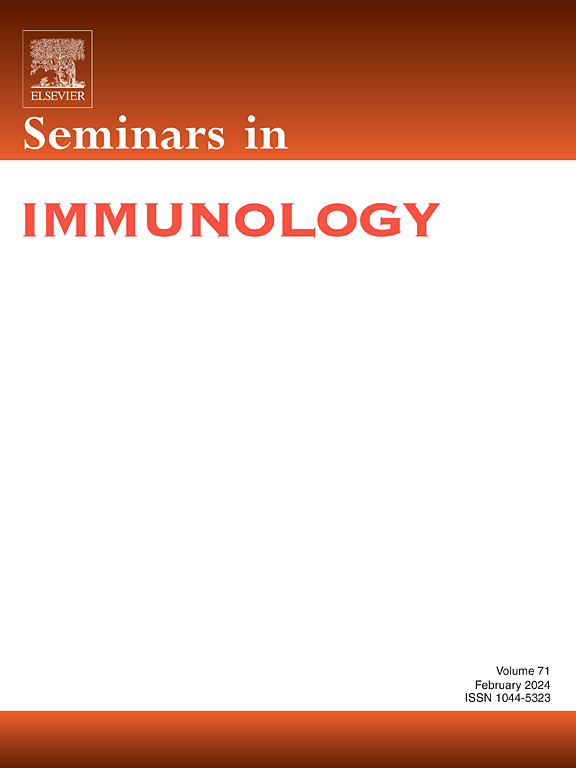溶瘤病毒合理设计的框架:考虑肿瘤微环境的整体视角
IF 7.4
2区 医学
Q1 IMMUNOLOGY
引用次数: 0
摘要
溶瘤病毒在建立免疫疗法作为下一代抗癌药物方面发挥了开创性的作用。最近的研究强调了肿瘤微环境对溶瘤病毒等免疫疗法疗效的影响,以及溶瘤病毒调节和重新配置这种微环境的能力。在这篇综述中,我们研究了大量和越来越多的证据,强调肿瘤微环境在决定溶瘤病毒治疗效果中的关键作用,同时也讨论了溶瘤病毒未来发展的潜在途径。在介绍了常用的溶瘤病毒和肿瘤微环境的组成部分之后,我们重点介绍了研究它们相互关系的最新研究。最后,讨论了三维建模的创新,以重建体外肿瘤微环境,随后检查了成功的案例研究,其中肿瘤微环境动力学为成功和量身定制的溶瘤病毒的合理设计提供了信息。通过这项研究,我们提供的证据表明,患者和肿瘤类型之间的肿瘤异质性显著阻碍了有效的溶瘤病毒治疗,因此我们建议考虑每个独特的肿瘤微环境动力学对于设计功能性和有效的溶瘤病毒治疗至关重要-无论是作为单一治疗还是与其他癌症治疗联合使用。本文章由计算机程序翻译,如有差异,请以英文原文为准。
A framework for the rational design of oncolytic viruses: A holistic perspective considering the tumour microenvironment
Oncolytic viruses have played a pioneering role in establishing immunotherapies as the next generation of anti-cancer medicines. Recent works have highlighted the impact the tumour microenvironment has on the efficacy of immunotherapies like oncolytic viruses, as well as the ability of oncolytic viruses to modulate and reconfigure this microenvironment. Within this review, we examine the vast and increasing evidence highlighting the pivotal role of tumour microenvironment in dictating oncolytic virotherapy efficacy, while also discussing potential avenues for the future development of oncolytic viruses. Following introductions to commonly used oncolytic viruses and components of the tumour microenvironment, we highlight recent research investigating their reciprocal relationships. Finally, innovations in 3D modelling to reconstitute the tumour microenvironment ex vivo are discussed, followed by examination of successful case studies in which tumour microenvironment dynamics have informed the rational design of successful and tailored oncolytic viruses. Through this, we provide evidence that substantial tumour heterogeneity amongst patients and tumour types significantly impedes effective oncolytic virotherapy, thus we suggest that consideration of each unique tumour microenvironment’s dynamics is critical for the design of functional and efficacious oncolytic virotherapy – both as a monotherapy or in combination with other cancer therapies.
求助全文
通过发布文献求助,成功后即可免费获取论文全文。
去求助
来源期刊

Seminars in Immunology
医学-免疫学
CiteScore
11.40
自引率
1.30%
发文量
50
审稿时长
89 days
期刊介绍:
Seminars in Immunology is a specialized review journal that serves as a valuable resource for scientists in the field of immunology. The journal's approach is thematic, with each issue dedicated to a specific topic of significant interest to immunologists. It covers a wide range of research areas, from the molecular and cellular foundations of the immune response to the potential for its manipulation, highlighting recent advancements in these areas.
Each thematic issue is curated by a guest editor, who is recognized as an expert in the field internationally. The content of each issue typically includes six to eight authoritative invited reviews, which delve into various aspects of the chosen topic. The goal of these reviews is to provide a comprehensive, coherent, and engaging overview of the subject matter, ensuring that the information is presented in a timely manner to maintain its relevance.
The journal's commitment to quality and timeliness is further supported by its inclusion in the Scopus database, which is a leading abstract and citation database of peer-reviewed literature. Being indexed in Scopus helps to ensure that the journal's content is accessible to a broad audience of researchers and professionals in immunology and related fields.
 求助内容:
求助内容: 应助结果提醒方式:
应助结果提醒方式:


